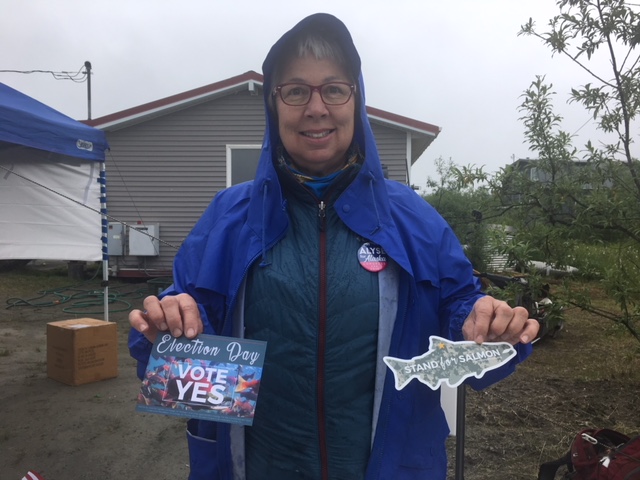
In the Yukon-Kuskokwim Delta, the stakes are especially high for the controversial Stand for Salmon ballot initiative because it could kill one of the biggest proposed gold mines in the world — the Donlin Mine.
Backers of Stand For Salmon visited Bethel a month ago. This is when Bethel resident Danielle Craven first heard of it.
“After learning about it, I realized that this was a coalition of people who are really interested that we as Alaskans and rural Alaskans have a voice in the decisions that are impacting salmon and our waters,” Craven said.
Craven is a member of the Orutsaramiut Native Council. The tribe held their first public demonstration against the proposed Donlin gold mine last week and is the first one to do so in the Yukon-Kuskokwim Delta. Craven sees Stand For Salmon as a way to protect the region’s subsistence way of life.
Craven is also one of the leaders of a new local working group called the Yukon-Kuskokwim River Alliance, and its goals align with the ballot initiative.
“We’re focused on educating and informing people about mining and Donlin Mine, protecting and preserving our subsistence way of life as well as educating those outside who don’t understand the reliance on subsistence living,” Craven said.
If voted in, Stand For Salmon would do a lot of things. First, it assumes that all bodies of water in Alaska supports salmon habitat until evidence proves the opposite. And it would require the Department of Fish and Game to hold big projects in salmon habitat to much tougher standards. It also gives Fish and Game more power to stop projects .
Emily Anderson at the Wild Salmon Center helped draft Stand For Salmon. She claims this is not an anti-mining or anti-development effort.
“This is a proactive way to get ahead of the curve to put strong fisheries protections standards in place that really encourage those responsible development projects that are not trading one resource for another,” Anderson said.
But if Stand For Salmon passes, it means Donlin Gold could not continue development, spokesman Kurt Parkan says.
“If the initiative passed, we wouldn’t be able to get the permits necessary to construct or operate the mine,” Parkan said.
According to legal documents filed by the state, the Donlin mine would permanently eliminate two streams that have had salmon in them. Stand for Salmon would require Donlin to restore those streams and other ones it damages, instead of shifting that to another place away from the mine. Parkan says because Donlin will be constructed in a remote and rural part of Alaska, it makes it “almost impossible to to satisfy mitigation requirements onsite.”
“So we, as well as other big projects in the state, look for offsite areas to mitigate and this initiative wouldn’t allow it to happen,” Parkan said.
And opponents claim Stand For Salmon could also have impacts on small-scale development, like a new road or bridge.
The Kuskokwim Corporationowns the surface rights to the Donlin mine. But the initiative’s effect on the mine isn’t as concerning as compared to the immediate consequences on rural development. TKC’s vice president Andrea Gusty says while the corporation doesn’t have a stance on Stand For Salmon, they do have concerns.
“What we worry is about the unintended consequences tomorrow if something like this did pass or could pass, on a projects like a road in Chuathbaluk so they could build new houses in communities or relocating a graveyard in Kalskag because of the problem of erosion,” Gusty said.
Donlin, along with several big mining companies, is backing Stand For Alaska, a group formed to oppose Stand For Salmon. The company has contributed $1.2 million in cash and donated time to Stand For Alaska so far. Parkan wouldn’t say if Donlin plans to contribute more. Conversely, Stand For Salmon has collected less than $500,000 from a wide range of contributors, including outside venture funds and individual Alaskan residents, according to state filings.
Meanwhile, Stand for Salmon is tied up in a legal fight over concerns that the initiative goes against Alaska’s constitution. So it’s unclear whether or not it even makes it to the ballot this fall.
